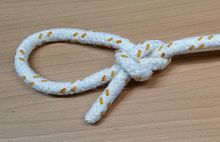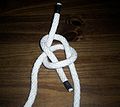Bowline
| Bowline | |
|---|---|

|
|
| Type | loop |
| application | General purpose loop |
| Ashley No. | 1010, 1034½, 1716, 1783, 1787, 2549, 2550 |
| strength | 64% |
| Synonyms | Bulin, bolein, stake stitch, shear rope knot, rescue knot / loop, simple anchor stitch |
| English | Bowline |
| List of nodes | |
The Palstek [ PALSTEK ] is a node , which for tying a fixed loop is applied. It is the most common knot used in seafaring.
Names and history
The bowline (in seafaring), also Bulin (from English: bowline , for mountaineers), is one of the most famous knots.
The boy scouts call it a shear rope knot or rescue loop . In the German fire brigade it is known as the fire rescue knot , chest collar and stake stitch . At the German THW it is called simple anchor stitch .
The name Palstek is Low German for Pfahlstich [from Niederd. Pa (h) l, mniederd. pāl = stake]. What is meant is a mooring line that connects a ship to a pole or dolphin .
The bowline was called the king of knots in a poem. However, the author raised it to this rank not because of its properties, but rather because of the observation that seafarers use it so often.
use
The bowline is easy to knot, holds well and is usually easy to loosen even after long and changing loads. If the ring is loaded, however, it can come loose unintentionally.
The knot strength of three-strand polyester lines is around 63%. Square braids and hollow braids make it around 49 to 55%. During an investigation of the 11 mm Superstatic rope in 1999, Edelrid measured a knot strength of 64%.
seafaring
The bowline is used as a mooring line in seafaring. To do this, the mooring line is laid as a fixed loop over the bollard or tied to a fixed point on land.
In the case of thick cables , a large loop is already put on the ship and connected to a throwing line, at the end of which a monkey fist or a small leather ball filled with sand serves as a throwing weight. The line is then thrown to a seaman standing on the pier , who pulls the thick hawser over to him and puts the prepared eye over the bollard .
When sailing , the sheet is tied to the clew of the sail with a bowline , or the halyard to the shackle at the head of the sail. There is contradictory discussion as to whether the inner or outer bowline is more suitable. Both forms have disadvantages.
Rescue services
The bowline is used by aid organizations under the name of rescue knot to close the chest or rescue waistband for water and height rescue . A chest band is put on the person to be rescued, which is tied tightly with the rescue knot. With water rescue this happens on the back, with height rescue in front of the chest of the person to be rescued. The rescue knot is the only knot that is approved for this purpose, as it cannot loosen itself and reduces the breaking strength of the rope significantly less than other knots.
Climb
Up until the early 1970s, the bowline served as a reliable rope knot and found its way into alpine literature. In November 1965, however, three mountain rescuers fell during a mountain rescue exercise on the Peilstein in Lower Austria due to an opening bowline. In tests carried out by Wastl Mariner , among others , it was found in the following months that the bowline holds itself in the knot under load as a rope knot until the rope breaks, but pulls up under ring load. This means that if there are several unevenly directed forces on the loop, the knot opens at 1.5 to 1.6 kN. The figure-eight knot was finally introduced as a replacement . It has a high knot strength and does not open even under ring loading.
Despite its publication in the specialist literature, the bowline was still used decades later, with further fatal accidents after ring loads (e.g. 1981 at Les Droites and 1983 at Olperer ). After another serious accident with an opening bowline at the 1992 World Cup in St. Pölten, it was only allowed to use figure eight knots. Its use has now been determined at international competition judge level.
The variations of double bulin and bulin 1.5 are often used for roping up .
Knot
First you put a small eye with the fixed part at the bottom. The loose end should be slightly longer than the circumference of the desired loop . The loose end is pulled into the eye from below. This creates the actual loop of the knot. Then you drive around the fixed end and back through the eye from above so that the two ends come out of the eye in parallel and can be tightened together.
It is crucial that you lead the loose end into the eye from the right side and vice versa back through the eye so that the two rope ends are parallel. If one dips into the eye from the wrong side, there will be no knot. To tighten, grasp the pulling end (upper rope) with one hand, the two parallel ends (the loose end and the parallel part of the loop) with the other hand and pull them tight (tighten).
A donkey bridge reads: "A snake emerges from the pond, crawls around the tree and dives back into the pond."
Video instructions for an external bowline
Outboard end
The bowline with the outside end has the end outside the eye. It is particularly suitable when the line is subject to changing loads (e.g. mooring line on a pole in rough seas or on a sail. A loose part on the inside can be pushed out over time and the knot can be opened). However, it has the disadvantage that the outer end can get caught on objects. This can be avoided through the extension to the Bulin 1.5 , which is preferably knotted from the bowline with the inner end.
Inner end
In the bowline with an inside end, the end is inside the eye. This variant is preferred if you want to prevent the loose part from getting stuck on other objects. However, it has the disadvantage that when the load changes, the end hits the object and the knot can thus loosen (for example when the sheet is attached to the clew of a sail with it). Again, this can be avoided by expanding the Bulin 1.5 .
Knot variant
An overhand knot with slip is tied into the loose end so that the fixed end forms the loop of the slip. The length of the remaining loose end should be long enough for the loop of the bowline. The loose end is then put through the loop. A bay is now formed with the loose end and the ends of the bay are held in place. Then the slip is pulled out of the overhand knot in such a way that the loop and the bay pull through the knot in such a way that the bowline with loop is created at the end.
This variant often causes the error that the little eye does not fold (the knot remains in the shape of part of image 3). This creates a running loop, with the short end - the loop - slipping out. The point of the knot is then not fulfilled and dangerous accidents occur.
Modifications
Water palstek
If you drag a bowline through the water, the water bowline (ABoK # 1012) is better. To do this, make another half hit with the standing part , so that the loose part is put through two eyes. This reduces pinching that occurs with wet knots.
Rundtörnpalstek
The Rundtörnpalstek (ABoK # 1013) is put through a double eye. French climbers used it because of its better lateral loading. However, it wasn't much more stable than the simple bowline either.
Prohaska bowline
Because the Rundtörnpalstek turned out to be not good enough as a rope knot, Heinz Prohaska developed this cross-resilient bowline variant in 2008. The Prohaska bowline is also started like a normal inwardly inserted bowline, but then the end is again put around one side and through the eye.
Schotstek
The Schotstek has a similar structure to the bowline , but instead of tying one end to its own part , the Schotstek has one end tied to a bay in the other end. The Schotstek is used to connect two ropes, but also serves almost any purpose.
Schotstek (ABoK # 1431)
Alternatives
Nowadays climbers use the figure-eight knot or the double bulin (also called double bowline ) to rope up . The Bulin 1.5 is also used in America .
The eye splice , which has a knot strength of 66%, is recommended for a constant eye .
If two loops are required, the Portuguese or Spanish bowline can be used . In Russia, instead of the cow hitch is often Kalmückenknoten used.
Individual evidence
- ↑ Fire Brigade Service Regulations 1 Training of Voluntary Fire Brigades, Committee on Fire Brigade Matters, Disaster Management and Civil Defense (AFKzV), 2007, p. 115f.
- ↑ Siren Song . In: The Lookout . Vol.XLIV, No. 3 , March 1953, p. 13 ( PDF ).
- ↑ vulnerability . In: boats . No. 10 , 2004 ( Online ( Memento from April 2, 2015 in the Internet Archive ) [PDF; 403 kB ; accessed on August 3, 2015]).
- ↑ Clifford W. Ashley: The Ashley Book of Knots. Over 3800 knots. How they look like. What they are used for. How they are made. 6th edition. Edition Maritim, Hamburg 2005, p. 196.
- ^ A b Heinz Prohaska: The Prohaska Palstek . In: kletterblatt . 2011, p. 24 ( online [accessed July 15, 2015]).
- ↑ Clifford W. Ashley: The Ashley Book of Knots. Over 3800 knots. How they look like. What they are used for. How they are made. 6th edition. Edition Maritim, Hamburg 2005, p. 272.
Web links
- Everything about the bowline - with detailed instructions and much more
- Klabautermann - animated graphics of the bowline and its variants
- Bowline bowline laid on slip - YouTube video (Slip Bowline)
- Bowline instructions for right, left, inserted, laid bowline


















